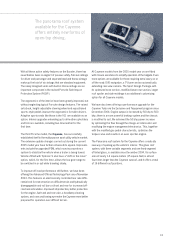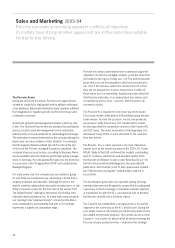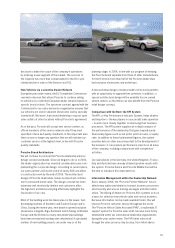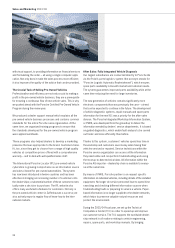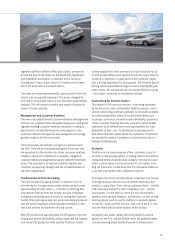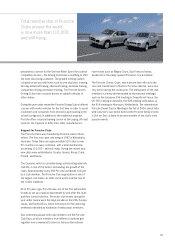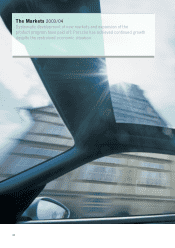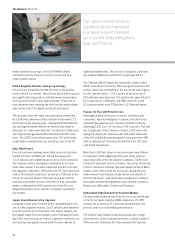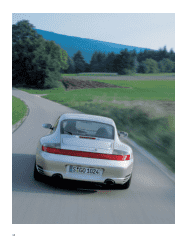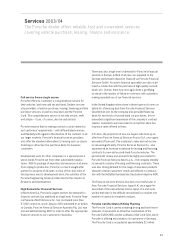Porsche 2003 Annual Report Download - page 47
Download and view the complete annual report
Please find page 47 of the 2003 Porsche annual report below. You can navigate through the pages in the report by either clicking on the pages listed below, or by using the keyword search tool below to find specific information within the annual report.
43
and Canada and the second largest market was Germany
with 16.1 percent of deliveries, but sales to other markets
amounted to 42.2 percent. The United Kingdom is also
gaining strongly in significance and is currently the third
largest individual market; other regions such as the Middle
East and Latin America are also increasing in importance.
Germany: Success in a Difficult Climate
Despite initial optimistic predictions, the economy in Germany
did not gather any significant momentum during the year
under review. Consumer spending in particular did not revive.
Nevertheless, with deliveries of 15,209 new vehicles – includ-
ing company cars and those leased to Porsche employees –
the preceding year’s result (13,179 units) was clearly exceeded.
This is mainly due to the Cayenne, but also to the 911, sales
of which exceeded expectations after the premiere of five new
versions – the 911 C4S Cabrio, the 911 Turbo Cabriolet, the
911 GT3 RS, the 911 GT2 and the “911 40th Anniversary”
special edition – at the German Motor Show in September 2003.
Porsche presented the new 911 to customers on July 16, 2004,
according to an organizational plan developed by Porsche
Germany GmbH for our 85 Porsche Centers. Using the motto
“911 Precision”, the two new 911 Carrera and 911 Carrera S
models were introduced to more than 64,000 guests by
means of an audio-visual presentation. The response was
extremely positive.
In spring 2004, Porsche Germany staged a roadshow with
the high performance Carrera GT sports car at 22 German
Porsche Centers. The Carrera GT was displayed to perfection
in a glass trailer towed by a Cayenne.
The dealers also demonstrated great commitment to the new
Boxster. Introduction of the limited edition “550 Spyder 50th
Anniversary” model in March 2004 triggered a significant
upturn in Boxster sales – a trend that is expected to continue
with the new Boxster model generation.
German Porsche Centers introduced the Cayenne with V6
engine to their customers in November 2003, using the
slogan “Family and Leisure Time”. This gave extra impetus to
sales of the Cayenne, which is the most popular premium SUV
with spark-ignition engine in Germany.
Overall, there was a further increase in the professionalism of
the sales organization during the year under review. Improve-
ments were made in the service management and sales con-
trol areas. The network of dealers was further expanded, with
a third location opened in Munich. Altogether, during the year
under review, German dealers invested EUR 31 million in the
renovation of their premises in accordance with the new brand
architecture.
North America: Stable Growth
North America remains Porsche’s largest market. It is there-
fore all the more fortunate that the economic situation there
has stabilized. This helped Porsche to increase deliveries to
customers during the review year by 32.4 percent to 32,763
vehicles, a total that includes Carrera GT deliveries. In the
figures that follow for the individual markets, these are not
shown separately because of the low total number involved.
The Cayenne’s great success in North America can also be
attributed to the launch of the six-cylinder version during the
review year. However, the Cayenne S and Cayenne Turbo
also enjoyed sustained popularity. Overall, in its first complete
year of availability the Cayenne SUV sold 17,457 units.
911 and Boxster deliveries fell by 15.3 percent to 15,225
units. However, 911 sales figures remained largely stable at
10,075 units (previous year 10,485 vehicles), despite the
impending change of model. This was for the most part due
to the great success of the new higher-value convertible
versions of the 911.
5,150 Boxster cars were sold, a drop of 31.3 percent. The
Boxster struggled against increasing competition and market
saturation in the roadster sector.
With 203 dealers in the USA and Canada, the size of the sales
network remained almost static, although further improve-
ments were implemented in terms of exclusivity and dealer
presentation. Porsche once again achieved high rankings in
Vehicle Deliveries in Units
Germany North America Japan Great Britain Other Markets
1999 ⁄ 00 2000 ⁄ 01 2001 ⁄ 02 2002 ⁄ 03 2003 ⁄ 04
80,000
60,000
40,000
20,000


